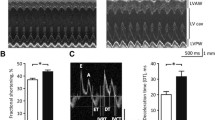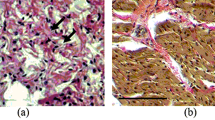Abstract
Rhythm disorders are common complications in diabetic patients, due to their enhanced sensitivity to ischaemia. However, experimental studies are inconsistent, and both higher and lower vulnerability to injury has been reported. Our objectives were to compare susceptibility to ventricular arrhythmias in rats with prolonged duration of diabetes induced hy streptozotocin (45 mg/kg, i. v.), utilising two different models. Following 8 weeks, either anaestetised open-chest rats in vivo or isolated Langendorff-perfused hearts were subjected to 30 min regional zero-flow ischaemia induced by occlusion of LAD coronary artery. In addition, cardiac glycogenolysis and lactate production were measured. In open-chest rats, 90% of the controls exhibited ventricular tachycardia (VT) which represented 55.4% of total arrhythmias, whereby only 19.9% of arrhythmias occurred as VT in 44% of the diabetic rats (P < 0.05 vs controls). Duration of VT and ventricular fibrillation (VF) was reduced from 35.5 ± 11.1 and 224.8 ± 153.9 s in the controls to 4.8 ± 2.5 and 2.2 ± 0.2 s in the diabetics, respectively (P < 0.05). Accordingly, severity of arrhythmias (arrhythmia score, AS) was also lower in the diabetics (2.0 ± 0.38 vs 3.3 ± 0.3 in the controls; P < 0.05). In the isolated hearts, high incidence of VF was decreased in the diabetic hearts, and although VT occurred in almost all of the diabetic hearts, the duration of VT and VF was substantially shorter (61.5 ± 14.5 and 5.5 ± 0.5 s vs 221.5 ± 37 and 398.5 ± 55 s in the controls, respectively; P < 0.05). AS was reduced to 2.9 ± 0.12 from 4.1 ± 0.3 in the controls (P < 0.05). Postischaemic accumulation of lactate was lower in the diabetic than in the non-diabetic myocardium (20.4 ± 1.9 vs 29.5 ± 2.9 μmol/l/g w.wt.; P < 0.05). These results suggest that rat hearts with chronic diabetes, despite some differences in the arrhythmia profiles between the in vivo model and isolated heart preparation, are less sensitive to ischaemic injury and exhibit lower susceptibility to ventricular arrhythmias and reduced accumulation of glycolytic metabolites.
Similar content being viewed by others
Author information
Authors and Affiliations
Additional information
Received: 3 April 2000, Returned for 1. revision: 9 May 2000, 1. Revision received: 5 July 2000, Returned for 2. revision: 7 August 2000, 2. Revison received: 11 September 2000, Returned for 3. revision: 27 September 2000, 3. Revision received: 13 October 2000, Accepted: 16 October 2000
Rights and permissions
About this article
Cite this article
Ravingerova, T., Neckar, J., Kolar, F. et al. Ventricular arrhythmias following coronary artery occlusion in rats: is the diabetic heart less or more sensitive to ischaemia?. Basic Res Cardiol 96, 160–168 (2001). https://doi.org/10.1007/s003950170066
Issue Date:
DOI: https://doi.org/10.1007/s003950170066




